by H.F. Schwartz, R.M Harveson and J.R. Steadman (3/13)
Quick Facts…
 |
Figure 1: Entire plant infected with Sclerotinia sclerotiorum.
|
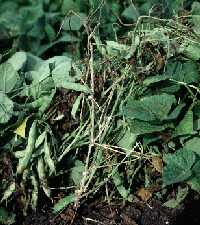 |
Figure 2: Symptoms of white mold disease. Note soft rotting on pods and white moldy growth. |
- Wet, cool weather near the end of the growing season is conducive to white mold epidemics.
- The fungus is soil-borne and infects lower parts of bean plants first.
- Infection often is localized initially within the more moist and cool irrigation furrows and in low-lying areas of a field.
- Disease management practices include crop rotation, recommended planting rates and row widths, varietal improvement, fungicidal sprays, and the efficient use of fertilizer and irrigation water.
One of the most important diseases affecting dry beans in western Nebraska and Colorado is white mold caused by the fungus Sclerotinia sclerotiorum. Losses from this disease have averaged as high as 20 percent, with a few individual field losses exceeding 65 percent.
White mold is first observed as wet, soft spots or lesions on infected leaves, branches, stems and pods. These lesions enlarge into a watery, rotten mass of tissue that is covered by a white moldy growth. Infection of stems and branches will cause affected plant parts to wilt and later die, taking on a bleached and dried appearance. This bleaching symptom is characteristic of white mold infected pinto and great northern types and differs from the normal tan color resulting from senescence (aging) or other diseases. Black and irregularly-shaped sclerotia (resting structures of the fungus) form on and within infected plant parts.
Spread and development of white mold is greatly influenced by the prevailing weather conditions and certain agronomic practices. The disease may cause serious yield losses during wet, cool periods near the end of the growing season. Agronomic practices, such as irrigation management, plant density and varietal growth characteristics, are all closely linked with the life cycle of the pathogen. Recent research has shown how management of these factors, in addition to the use of chemical control, can be most effectively combined to reduce disease severity and minimize yield losses to bean Crops.
Survival of the Fungus
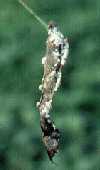 |
Figure 3: Sclerotial formation on infected pod; white moldy growth darkens with age and forms sclerotia. |
The most important survival mechanism of S. sclerotiorum is the formation of sclerotia. A sclerotium is a compact mass of hardened mycelium (cobweb-like fungal threads) that contains reserve food materials. These structures are produced in abundance on infected plant tissue, allowing the fungus to survive during periods of unfavorable environmental conditions.
Sclerotia usually are dark colored, circular to irregular in shape, and range in size from less than 1/8 inch in diameter up to the size of a large bean seed. The center of a sclerotium usually is cream or white. Studies have shown that up to 75 percent of sclerotia buried 12 inches deep in a bean field remain alive and infective three years or longer.
Sclerotinia sclerotiorum can survive from one season to the next as mycelium in infected bean straw and seeds that have been scattered over the field during harvest. Post-harvest tillage reduces the potential for infection since diseased tissue is turned under and generally decomposes in the soil before the next bean growing season. However, sclerotial survival still can be a problem in subsequent seasons.
The fungus can be transported within infected seeds or in sclerotia-contaminated seed lots to be planted during the next growing season. Therefore, it is important to plant only certified seeds that have had sclerotia and poor quality seeds removed during threshing and cleaning operations.
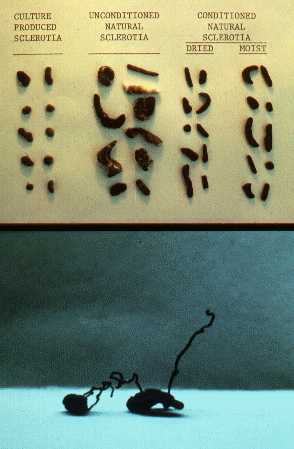 |
Figure 4: Sclerotia or resting structures of the fungus. Bottom: Sclerotia germinating, producing stipes. |
Infection of Beans
Since sclerotia provide the main source of initial inoculum, they must germinate before infection of bean plants can occur. A sclerotium may germinate by either of two methods. It may germinate directly by producing white
mycelial strands, which seldom exceed 1/2 inch in length. These strands usually do not penetrate living plant tissue until after they have colonized dead or senescent parts such as flowers or leaves. This form of germination
does not occur frequently in bean fields in western Nebraska or in Colorado.
More commonly, a sclerotium germinates by producing one or more dark germ tubes or stipes that grow upward from a soil depth of less than 2 inches toward the soil surface. Upon reaching the surface, the tip of this germ tube is stimulated by light to develop into a small — 1/8 to 1/4 inch in diameter — flesh-colored and mushroom-like structure called an apothecium. These are first observed about 60 days after planting, which coincides with partial to complete row cover. An individual sclerotium can produce numerous apothecia simultaneously or sequentially throughout the growing season. Each apothecium produces millions of spores (fungus seeds) beneath the plant canopy. These are periodically released and spread to nearby plants.
Infection resulting from spore dissemination from field to field is not of great importance. Irrigation runoff water is known to transport suspended spores, mycelia and sclerotia within and between fields.
The fungus spores must come in contact with and colonize dead or senescent plant tissue such as flowers on the soil surface beneath the plant canopy. These colonized flowers also may be lodged in branch axils or stuck to developing pods. After colonization of this dead tissue, the fungus can then directly invade healthy tissue and produce the typical watery soft rot symptoms and subsequently new sclerotia. The disease then moves rapidly within and between adjacent plants in the field. White mold infection is often localized initially within the more moist and cool irrigation furrows and in low-lying areas of a field.
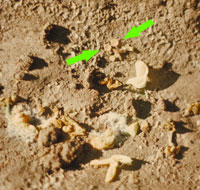 |
Figure 5: Fungal growth on senescent blossoms and leaves; note apothecia on soil surface. |
White Mold Management
No single control or disease management measure effectively prevents the infection process. However, each of the various measures can reduce the damage caused by white mold and thereby minimize yield losses.
Since white mold sclerotia can survive for many years in the soil, crop rotation generally does not prevent infection.
However, this practice does help reduce the number of sclerotia within the field, and hence the potential for disease loss. Conversely, continuous cropping of beans increases the potential for damage and yield losses, not only from white mold but also from root rots and bacterial blights. Therefore, it is recommended that bean fields be rotated in a three-year cropping cycle that does not include dry beans, soybeans, sunflowers or other susceptible hosts.
Cultural practices that minimize excessive vine growth also reduce disease potential. Thick, dense growth causes lower temperatures and high moisture beneath the plant canopy — conditions that are favorable for disease. Plant excessively viny varieties only on coarse-textured soils and well-sloped land. To avoid excess canopy development, apply fertilizer rates only within the recommended levels. High plant populations and narrow row widths can influence white mold development, especially in fields with a known history of the disease. It is advisable to use recommended planting rates and row widths to avoid dense canopies. Fields with a history of white mold should not be planted to drilled beans.
Efficient use of irrigation water also is important because progressive development of the disease depends on a moist soil surface beneath the plant canopy. White mold infection can be greatly reduced by keeping the soil surface as dry as possible during pod filling and maturing. Therefore, apply irrigation water only when required by the crop for satisfactory growth. If practical, holding ponds or other crop reuse systems (hay or corn land, for example) may be used to trap bean field irrigation runoff. This prevents contaminating irrigation systems or other bean fields with infested debris or pathogen structures of S. sclerotiorum or other pathogenic organisms.
Another control measure to consider is the use of fungicidal sprays. While university test results may vary from year to year, boscalid (Endura) and thiophanate methyl (Topsin M) have provided a satisfactory degree of white mold disease management. Apply the chemical when 50 to 100 percent of the plants have one or more flowers and small pods — less than 1/4 inch long. Timing of fungicidal application is critical to protect as many blossoms as possible from infection. The fungicide must be applied in sufficient water to provide thorough coverage of blossoms, stems and leaves, especially those closest to the soil surface. Chemical management is more effective for plants with upright growth habits.
Varietal improvement by breeding for disease resistance and a more open plant canopy continues to be studied at the University of Nebraska and Colorado State University. Incorporation of these new varieties within an overall disease management strategy that includes adequate crop rotation, cultural practice modifications, efficient fertilizer and irrigation practices and the application of fungicides will effectively reduce losses from white mold of dry beans.
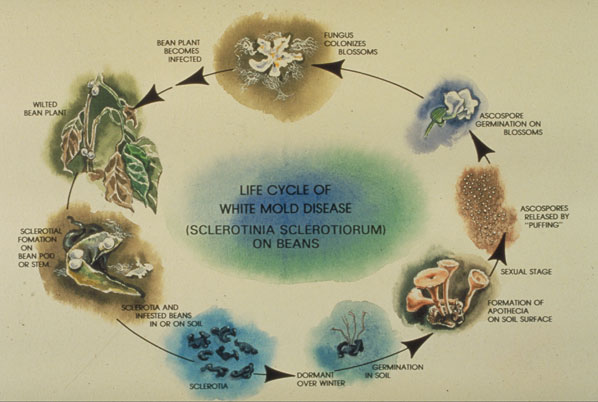 |
Figure 6: Life cycle of white mold disease (Sclerotinia sclerotiorum) on beans. |
*H.F. Schwartz, Colorado State University Extension plant pathologist and professor, bioagricultural science and pest management; R.M. Harveson and J.R. Steadman, University of Nebraska. Portions are from regional Extension publication 562A, Dry Bean Production and Pest Management, by H.F. Schwartz, M.A. Brick, R.M. Harveson and G.D. Franc. Revised 5/11.
Go to top of this page.





